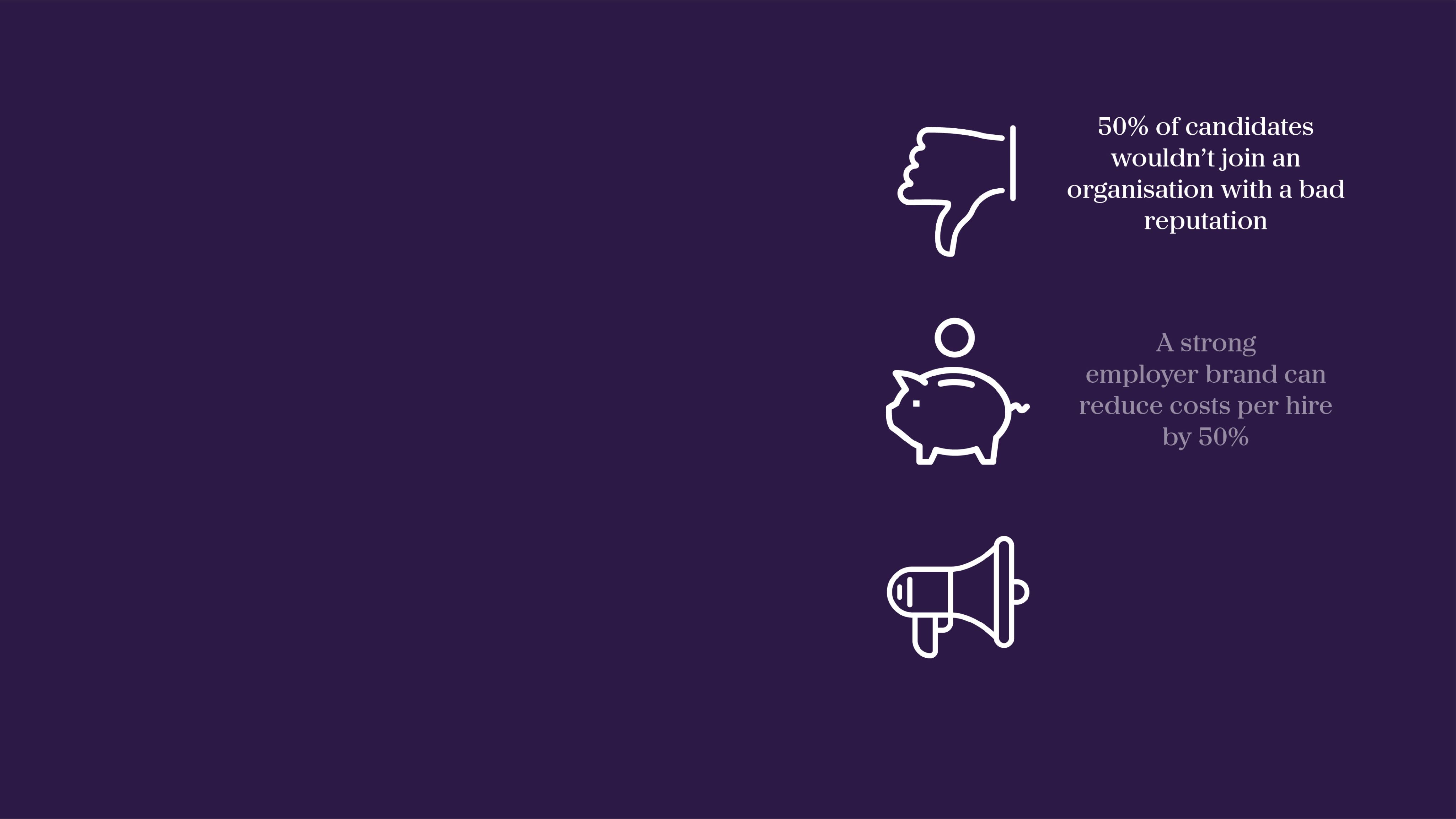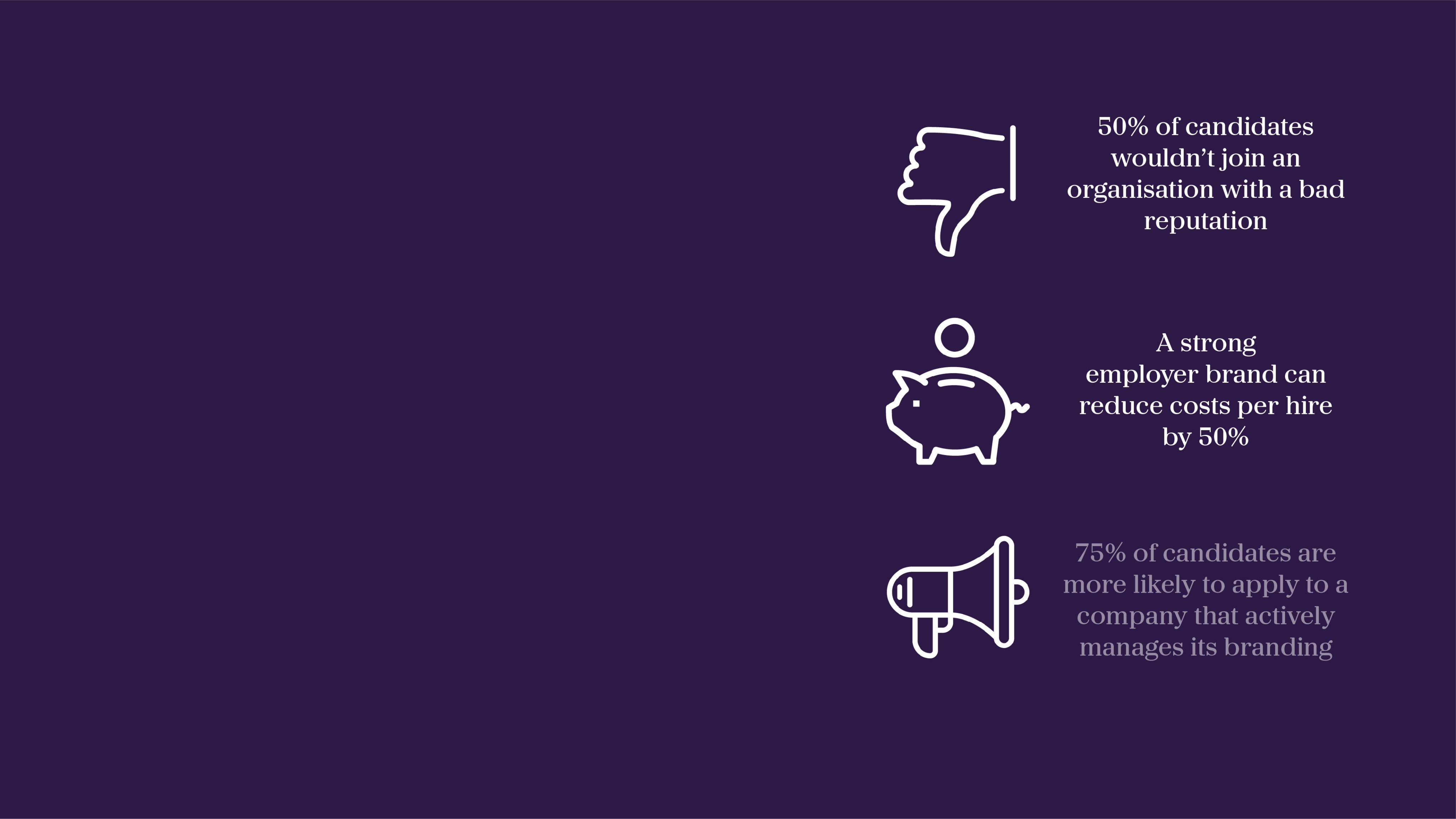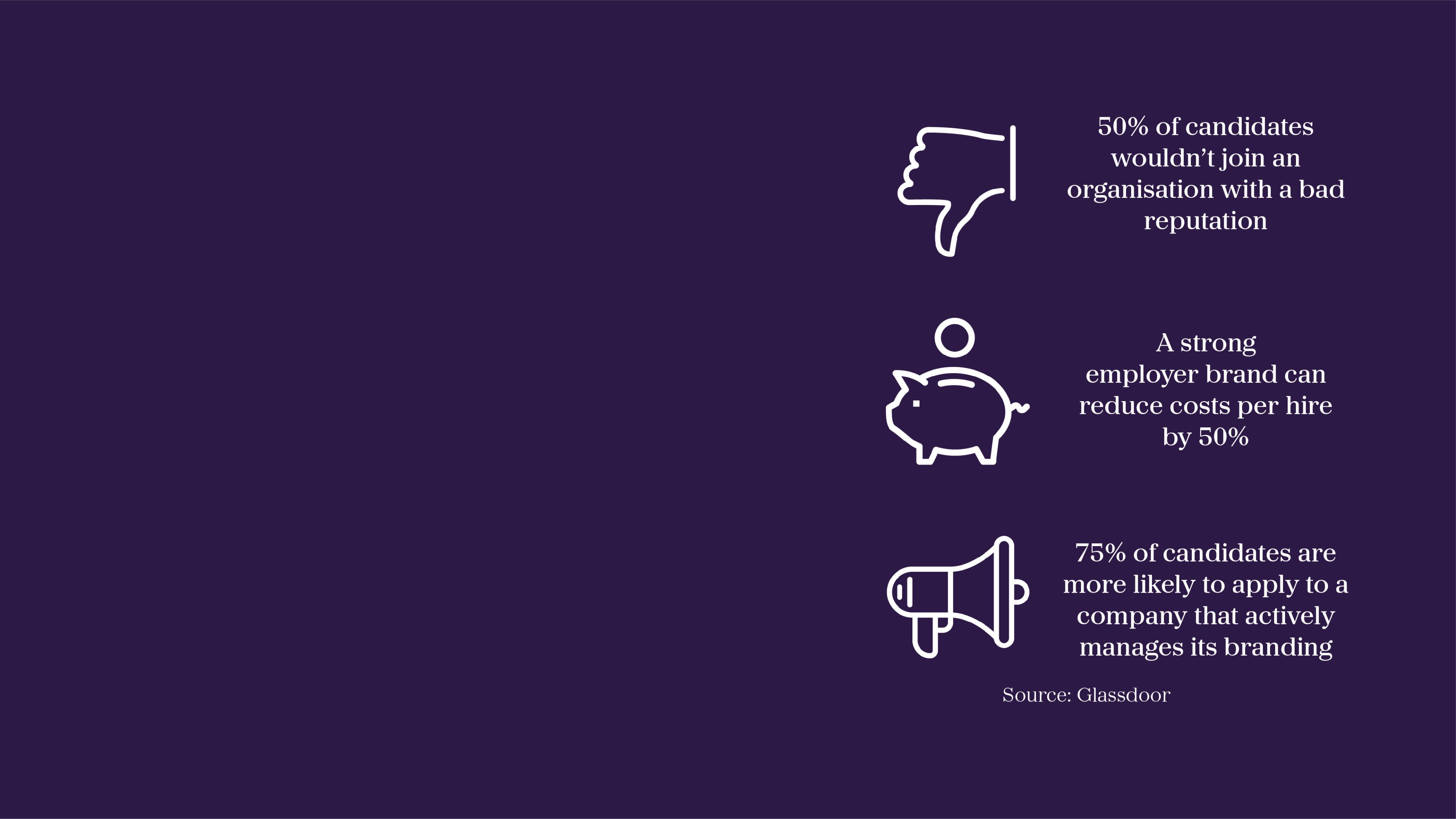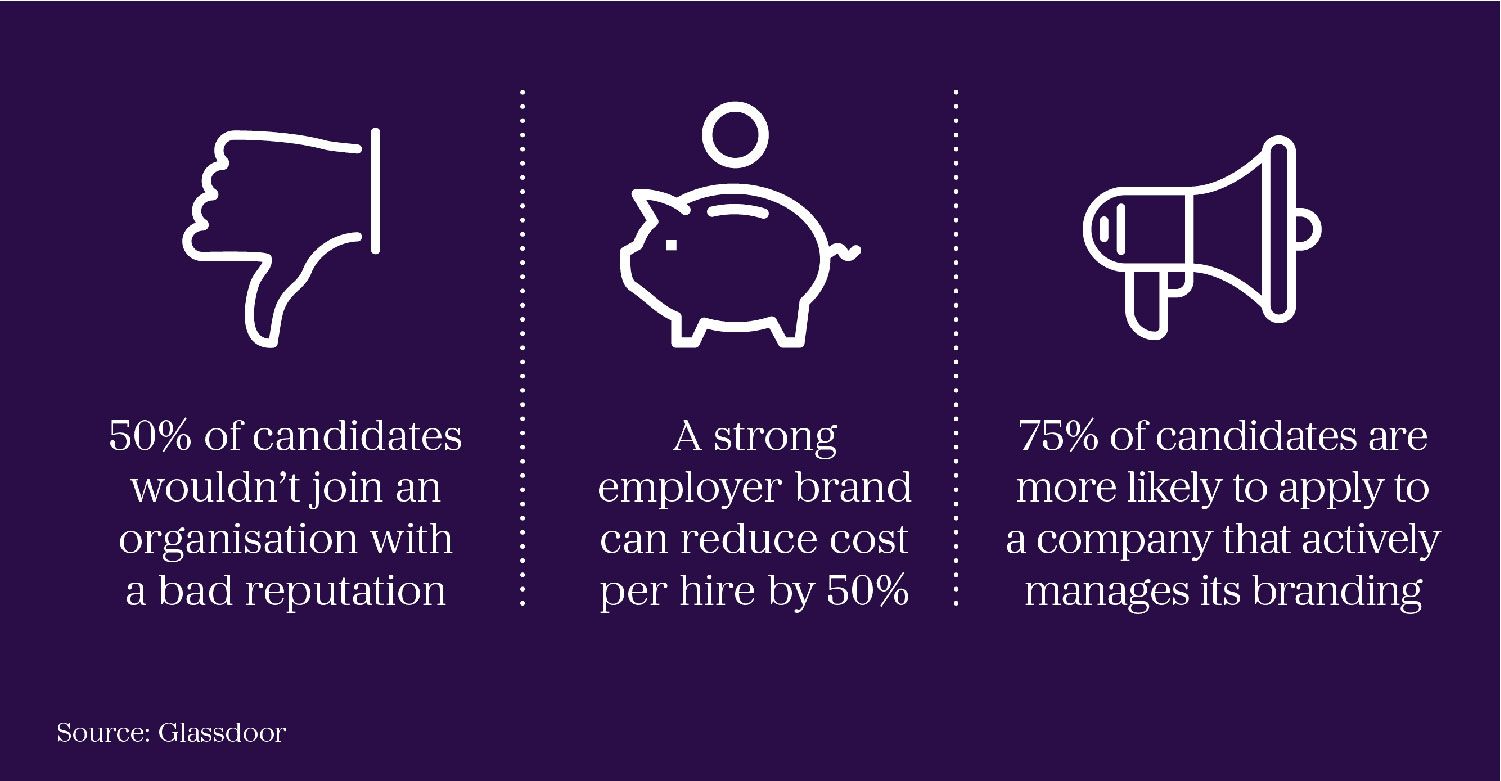It’s plain as day -
employer brand really is everything
Contributors:
Bryan Adams, CEO, Ph.Creative
Bill Cleary, Managing Director, AMS
Terina Matthews-Davis, Client Director, AMS

In a tough, candidate-led jobs market, the traditional approach to talent acquisition is over. Employers are increasingly having to convince candidates that their company is the right one to join, offering a combination of purposeful work, development opportunities and values that match the individual. C-suite conversations around employer branding are growing.
As with many other future of work concepts, the COVID-19 pandemic has had a catalysing effect on employer branding. Faced with a genuine global crisis, business leaders were forced to not only communicate their values, but demonstrate them.
Lockdowns, physical and mental health challenges and a potential recession meant that employers had to decide whether common company values like trust, honesty and integrity were things to live by, or just words that sounded good.
Now the Great Resignation has hit and employers are struggling to fill talent gaps. Differentiating yourself from your competitors is key when the talent pool is shrinking - and talent is watching.
According to Glassdoor, 86% of women and 67% of men wouldn’t join a company with a bad reputation. Half of all candidates wouldn’t join a company with a bad reputation even if they offered them a pay rise. On the flipside, three-quarters of jobseekers are more likely to apply to a job if the employer actively manages its employer brand and 92% of people would consider switching jobs to a company with an excellent corporate reputation.
For recruiters, employer brand is important too. The same report suggests that a strong employer brand can reduce cost per hire by as much as 50%, with a negative reputation adding an extra 10% onto each hire.
“Brand is a differentiator, so for companies it’s about how do I promote my brand and make candidates aware of it, but also meet them where they’re at,” says Bill Cleary, managing director, advisory at AMS.
“This might mean identifying the different personas of the candidates you’re trying to hire and differentiating your brand message along those lines. It’s about being custom to the individuals and personas you’re trying to attract,” adds Cleary.
Creating an employer brand
Bryan Adams is CEO and founder of North American based employer brand agency Ph.Creative. He believes that there are plenty of misconceptions around how organisations can create an authentic employer brand. To begin with, he advises companies to focus on three key components: reputation, proposition and experience.
“Modern jobseekers weigh a prospective employer’s reputation heavily in their decision to apply for a job or accept an offer, because they’re keenly aware of the impact it will have on their own reputation and the way others perceive them,” he writes.
Like Cleary, Adams believes reputation can mean different things to different employees, so it’s important to segment different personas. This leads onto proposition, which defines the employee-employer relationship. This establishes the expectations that the company has for employees and how they will be rewarded. The key here is honesty - a mismatch in expectations can lead to lasting damage on your brand.
Finally comes experience. Good employee experience is vital in building your reputation, providing excellent - and sometimes vocal - feedback on what it’s like to work at your organisation.
As Adams writes: “Much as satisfied customers can often make the best salespeople, satisfied current and former employees can be an invaluable source of candidate referrals, strengthening your ability to attract top talent.”
The graduate landscape
One of the most competitive areas of recruitment is in the graduate and future talent area - and it’s a demographic that is heavily invested in employer branding.
Terina Matthews-Davis is Americas client director, early careers and campus for AMS. She believes that companies are having to be more creative and personalize their offerings to attract the next generation of candidates. It’s about giving students the opportunity to see places they wouldn’t normally get to go to on their own.
“In New York for example, instead of taking all interns to a Yankees or Mets game, companies are thinking ‘maybe not all our people are interested in baseball, so let’s give them a choice and split up our business leaders to go to different events/locations such as: Radio City Music Hall, backstage tour of a Broadway production, an event at the Metropolitan Museum Art, or even a guided tour of Central Park.’ It’s about giving them options to not only engage with the company, but also the city they’re going to be living and working in,” she says.
The candidate-driven market means that employers are having to temper expectations about when interns accept offers. Such is the volume of opportunities, that all candidates can be more selective about where they work.
“Companies used to ask interns to make decisions about offers immediately or within 2 – 4 weeks. In the current market, organizations have to be OK with interns shopping around for additional full-time opportunities, before making their final decision to accept or decline their intern conversion offer.” says Matthews-Davis.
To combat this, businesses need to up their engagement strategies. A starting point is to focus on young talent as mentors, giving prospective employees the opportunity to learn and hear from employees who have just been through the journey they’re starting.
Secondly, companies are recruiting from more diverse populations and colleges, doing away with the core school mentality of only recruiting from certain institutions.







In a tough, candidate-led jobs market, the traditional approach to talent acquisition is over. Employers are increasingly having to convince candidates that their company is the right one to join, offering a combination of purposeful work, development opportunities and values that match the individual. C-suite conversations around employer branding are growing.
As with many other future of work concepts, the COVID-19 pandemic has had a catalysing effect on employer branding. Faced with a genuine global crisis, business leaders were forced to not only communicate their values, but demonstrate them.
Lockdowns, physical and mental health challenges and a potential recession meant that employers had to decide whether common company values like trust, honesty and integrity were things to live by, or just words that sounded good.
Now the Great Resignation has hit and employers are struggling to fill talent gaps. Differentiating yourself from your competitors is key when the talent pool is shrinking - and talent is watching.
According to Glassdoor, 86% of women and 67% of men wouldn’t join a company with a bad reputation. Half of all candidates wouldn’t join a company with a bad reputation even if they offered them a pay rise. On the flipside, three-quarters of jobseekers are more likely to apply to a job if the employer actively manages its employer brand and 92% of people would consider switching jobs to a company with an excellent corporate reputation.
For recruiters, employer brand is important too. The same report suggests that a strong employer brand can reduce cost per hire by as much as 50%, with a negative reputation adding an extra 10% onto each hire.

“Brand is a differentiator, so for companies it’s about how do I promote my brand and make candidates aware of it, but also meet them where they’re at,” says Bill Cleary, managing director, advisory at AMS.
“This might mean identifying the different personas of the candidates you’re trying to hire and differentiating your brand message along those lines. It’s about being custom to the individuals and personas you’re trying to attract,” adds Cleary.
Creating an employer brand
Bryan Adams is CEO and founder of North American based employer brand agency Ph.Creative. He believes that there are plenty of misconceptions around how organisations can create an authentic employer brand. To begin with, he advises companies to focus on three key components: reputation, proposition and experience.
“Modern jobseekers weigh a prospective employer’s reputation heavily in their decision to apply for a job or accept an offer, because they’re keenly aware of the impact it will have on their own reputation and the way others perceive them,” he writes.
Like Cleary, Adams believes reputation can mean different things to different employees, so it’s important to segment different personas. This leads onto proposition, which defines the employee-employer relationship. This establishes the expectations that the company has for employees and how they will be rewarded. The key here is honesty - a mismatch in expectations can lead to lasting damage on your brand.
Finally comes experience. Good employee experience is vital in building your reputation, providing excellent - and sometimes vocal - feedback on what it’s like to work at your organisation.
As Adams writes: “Much as satisfied customers can often make the best salespeople, satisfied current and former employees can be an invaluable source of candidate referrals, strengthening your ability to attract top talent.”
The graduate landscape
One of the most competitive areas of recruitment is in the graduate and future talent area - and it’s a demographic that is heavily invested in employer branding.
Terina Matthews-Davis is Americas client director, early careers and campus for AMS. She believes that companies are having to be more creative and personalize their offerings to attract the next generation of candidates. It’s about giving students the opportunity to see places they wouldn’t normally get to go to on their own.
“In New York for example, instead of taking all interns to a Yankees or Mets game, companies are thinking ‘maybe not all our people are interested in baseball, so let’s give them a choice and split up our business leaders to go to different events/locations such as: Radio City Music Hall, backstage tour of a Broadway production, an event at the Metropolitan Museum Art, or even a guided tour of Central Park.’ It’s about giving them options to not only engage with the company, but also the city they’re going to be living and working in,” she says.
The candidate-driven market means that employers are having to temper expectations about when interns accept offers. Such is the volume of opportunities, that all candidates can be more selective about where they work.
“Companies used to ask interns to make decisions about offers immediately or within 2 – 4 weeks. In the current market, organizations have to be OK with interns shopping around for additional full-time opportunities, before making their final decision to accept or decline their intern conversion offer.” says Matthews-Davis.
To combat this, businesses need to up their engagement strategies. A starting point is to focus on young talent as mentors, giving prospective employees the opportunity to learn and hear from employees who have just been through the journey they’re starting.
Secondly, companies are recruiting from more diverse populations and colleges, doing away with the core school mentality of only recruiting from certain institutions.
Finally, Matthews-Davis says companies are learning to invest in student populations over the long-term.
“When I was in-house building this population, we had a ‘keep warm’ policy. From when an intern accepts an offer to when they actually start can be nearly a year, so you need to keep them engaged so they don’t shop around.
“One way is to send them gifts. In certain sectors, it’s a badge of honor to have a duffel bag or vest with a company logo. So, companies are upping their game, sending out brands like Patagonia and North Face to keep engaged,” says Matthews-Davis.
This also provides employers with a chance to interact with future hires by surveying them on the sort of gifts they would like. By asking their opinion, brands can show this talent pool that their thoughts are valued, turning them into potential brand ambassadors as they show off their gifts to fellow students.
The challenge of this focus on employer branding is to match expectation with reality. Matthews-Davis believes there is a danger that entry-level talent could become ‘over-entitled’ and have unrealistic expectations around the speed of career trajectories. To combat this, she suggests that companies should provide mentoring from other employees explaining their career paths.
Ultimately, no amount of good branding can keep talent if the actual experience of working somewhere is different.
“What talent wants is true, authentic leaders that they can engage with. They want a balance of value-added work and development within the organization. Those things haven’t changed,” says Matthews-Davis.
written by the Catalyst Editorial Board
with contributions from:
Bryan Adams, CEO, Ph.Creative
Bill Cleary, Managing Director, AMS
Terina Matthews-Davis, Client Director, AMS

Finally, Matthews-Davis says companies are learning to invest in student populations over the long-term.
“When I was in-house building this population, we had a ‘keep warm’ policy. From when an intern accepts an offer to when they actually start can be nearly a year, so you need to keep them engaged so they don’t shop around.
“One way is to send them gifts. In certain sectors, it’s a badge of honor to have a duffel bag or vest with a company logo. So, companies are upping their game, sending out brands like Patagonia and North Face to keep engaged,” says Matthews-Davis.
This also provides employers with a chance to interact with future hires by surveying them on the sort of gifts they would like. By asking their opinion, brands can show this talent pool that their thoughts are valued, turning them into potential brand ambassadors as they show off their gifts to fellow students.
The challenge of this focus on employer branding is to match expectation with reality. Matthews-Davis believes there is a danger that entry-level talent could become ‘over-entitled’ and have unrealistic expectations around the speed of career trajectories. To combat this, she suggests that companies should provide mentoring from other employees explaining their career paths.
Ultimately, no amount of good branding can keep talent if the actual experience of working somewhere is different.
“What talent wants is true, authentic leaders that they can engage with. They want a balance of value-added work and development within the organization. Those things haven’t changed,” says Matthews-Davis.
written by the Catalyst Editorial Board
with contributions from:
Bryan Adams, CEO, Ph.Creative
Bill Cleary, Managing Director, AMS
Terina Matthews-Davis, Client Director, AMS
